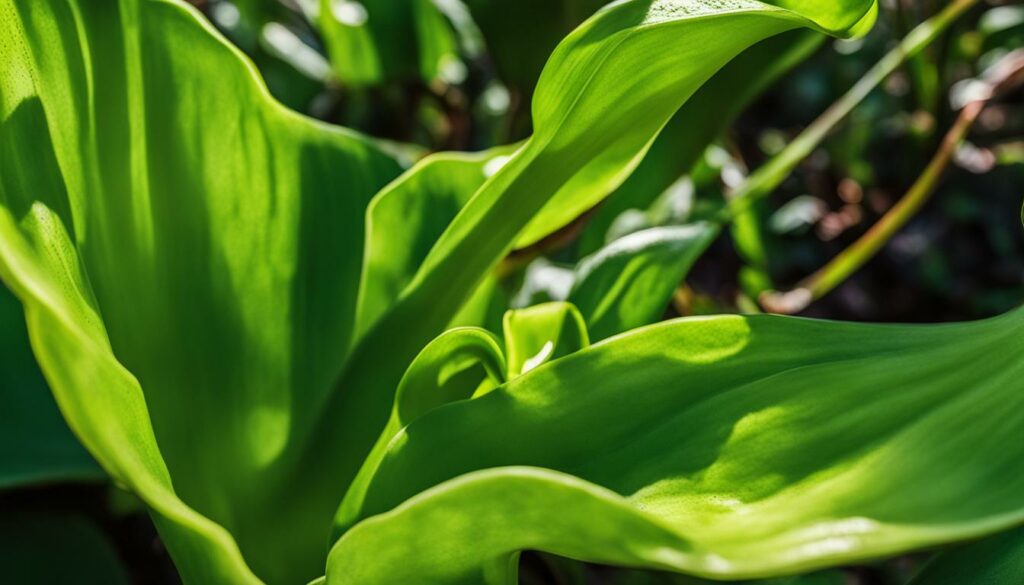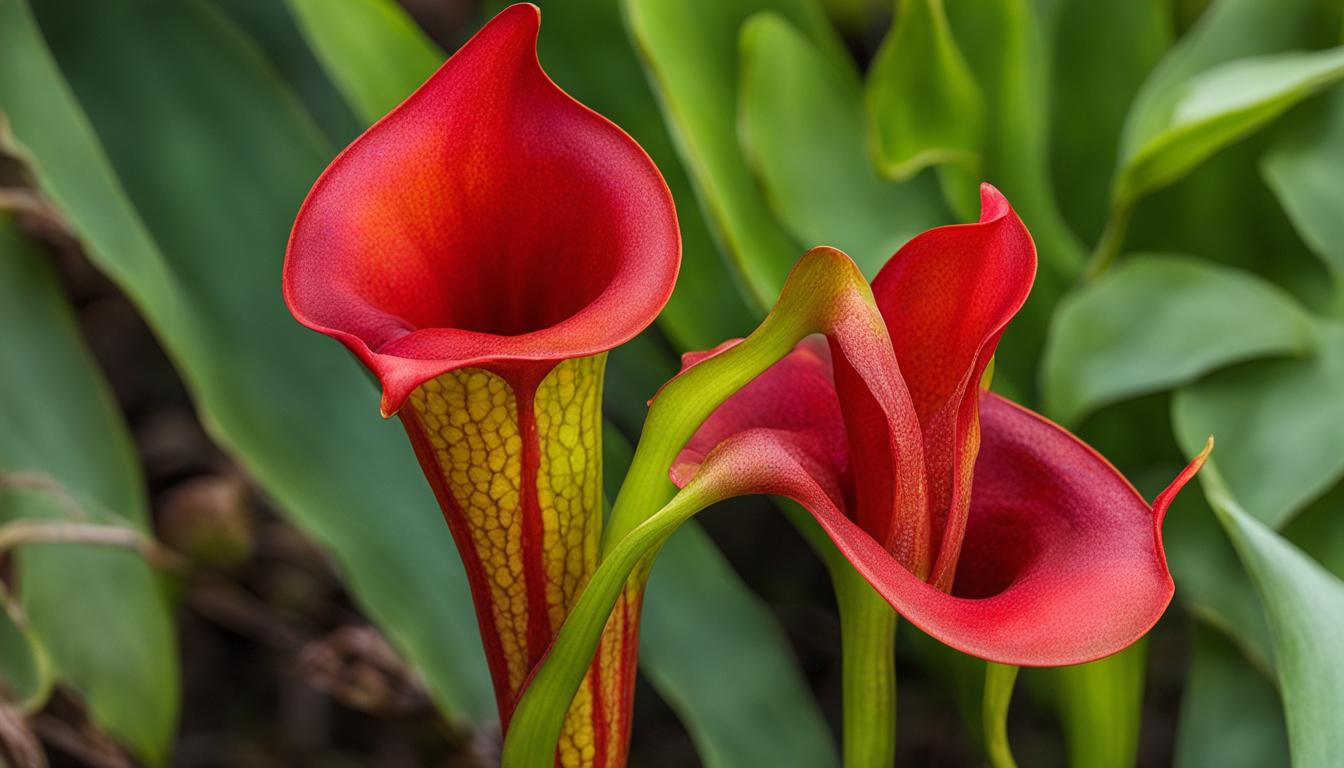Welcome to our comprehensive Trumpet Pitcher Plant Care Guide! Whether you’re a plant enthusiast or just starting out, this guide will provide you with all the information you need to keep your Trumpet Pitcher Plants healthy and thriving.
The Trumpet Pitcher Plant, also known as Sarracenia, is a fascinating carnivorous plant that can be grown both indoors and outdoors. Its unique appearance and ability to trap and digest insects make it a captivating addition to any plant collection.
In this guide, we’ll dive into the specifics of caring for Trumpet Pitcher Plants. From their sunlight and water requirements to potting and propagation tips, we’ve got you covered. By following our care instructions, you can ensure that your Trumpet Pitcher Plants are happy and flourishing.
So, let’s get started on this exciting journey of Trumpet Pitcher Plant care!
About the Pitcher Plant
Trumpet Pitcher Plants, also known as Sarracenia, are a type of carnivorous plant that have a unique and captivating appearance. They have long, tubular leaves with colorful markings and veins, which serve as pitchers to trap and digest insects. Pitcher Plants can be grown as houseplants or in outdoor gardens, and they require specific care to thrive. While they can be challenging to grow, following the right care instructions will help you successfully cultivate these fascinating plants.
These plants are native to North America and are found in wetland areas, such as bogs and swamps. They have adapted to nutrient-poor environments by evolving unique mechanisms to capture and digest insects. The pitchers of the Trumpet Pitcher Plant are filled with a liquid that attracts insects, and once trapped inside, the digestive enzymes gradually break down the prey. This allows the plant to obtain the necessary nutrients it needs to survive.
“Trumpet Pitcher Plants have evolved to become masterful insect trappers, with their pitchers acting as ingenious traps that lure in unsuspecting insects and provide the plant with nourishment.”
Growing Conditions
Trumpet Pitcher Plants thrive in bright, indirect sunlight. They should be placed in a location that receives at least 6 hours of sunlight per day. If grown indoors, a south-facing window is ideal. In terms of temperature, these plants prefer a range of 60-85°F (15-29°C) during the growing season and can tolerate temperatures as low as 40°F (4°C) during their dormant period. It’s important to provide them with a humid environment, as they prefer high humidity levels. If the air in your home is dry, you can use a humidifier or place the plant on a tray with water and pebbles to increase humidity.
Soil and Watering
Trumpet Pitcher Plants require well-draining soil that is low in nutrients. A mixture of sphagnum moss and perlite or sand works well. It’s important to use distilled water, rainwater, or reverse osmosis water when watering these plants, as tap water can contain high mineral content that can harm them. Allow the soil to dry out slightly between waterings, but never let it completely dry. Keep the soil moist at all times, as these plants rely on a constant supply of water to thrive.
Feeding and Maintenance
Trumpet Pitcher Plants are carnivorous and obtain their nutrients from captured insects. They do not require additional feeding or fertilization. In fact, fertilizing these plants can be detrimental to their health. Allow the pitchers to fill with rainwater or distilled water, as this provides the necessary nutrients for the plant. It’s important to remove any dead or dying pitchers to maintain plant health.
| Light | Temperature | Humidity | Watering |
|---|---|---|---|
| Bright, indirect sunlight | 60-85°F (15-29°C) | High humidity | Keep soil moist at all times, use distilled or rainwater |
Trumpet Pitcher Plant Care Instructions
Proper care is essential for the health and well-being of your Trumpet Pitcher Plants. Here are some essential care tips to help you maintain these unique carnivorous plants:
1. Sunlight:
Trumpet Pitcher Plants thrive in bright sunlight, so make sure to place them in a location that receives full sun or very bright light. Ideally, they should get at least six hours of direct sunlight daily to promote optimal growth and pitcher development. If you’re growing them indoors, consider placing them near a south-facing window or under grow lights to ensure they receive enough light.
2. Watering:
These plants require a consistently wet or moist environment to thrive. It’s important to keep the soil or growing medium damp at all times. Water them regularly, ensuring that the soil doesn’t dry out completely. Use rainwater, distilled water, or soft tap water to water your Trumpet Pitcher Plants, as they require acidic water to maintain their health. Avoid using hard tap water or any water that contains high mineral content, as it can be harmful to the plants.
3. Fertilization:
Unlike most plants, Trumpet Pitcher Plants do not require fertilization. They obtain all the necessary nutrients from the insects they catch and digest in their pitchers. Feeding them with plant food or fertilizer can actually harm the plants and disrupt their natural feeding process. It’s best to let them obtain their nutrients naturally through their carnivorous behavior.
4. Temperature:
Trumpet Pitcher Plants can tolerate a wide range of temperatures, but they prefer warm to hot conditions during the growing season and cooler temperatures during their dormant period. Ideally, they should be kept in an environment with temperatures between 70-85°F (21-29°C) during the active growth phase. During dormancy, which typically occurs in winter, temperatures between 40-60°F (4-15°C) are generally suitable.

By following these care instructions, you can ensure the health and happiness of your Trumpet Pitcher Plants. Remember to provide them with ample sunlight, maintain a consistently moist environment, avoid fertilization, and provide suitable temperature conditions. With proper care, these unique carnivorous plants will thrive and bring a touch of natural beauty to your home or garden.
Potting and Repotting Trumpet Pitcher Plants
Proper potting and repotting are essential for the health and longevity of your Trumpet Pitcher Plants. These unique carnivorous plants require a specific type of potting soil that mimics their natural habitat. The right growing medium will provide the necessary nutrients and a well-draining environment for the plants to thrive.
When potting your Trumpet Pitcher Plants, it’s important to use a mixture of sand and peat moss, or you can opt for a pre-packaged compost specifically designed for carnivorous plants. This soil mix will provide the necessary acidity and moisture retention that these plants require. It’s best to avoid regular potting soil, as it may contain additives or fertilizers that can harm the plants.
Repotting is typically only necessary every 2 to 3 years, but it can help refresh the growing medium and remove any mineral build-up. When repotting, make sure to choose a pot that is slightly larger than the current one to allow for growth. Carefully remove the plant from its old pot, being mindful of the delicate pitchers and roots. Gently loosen the root ball and place the plant in the new pot, making sure to maintain the proper depth for the rhizome, which is the important part of the plant that sits below and above the soil. Fill the remaining space with the potting mix, lightly pressing it down to secure the plant.
Remember to keep your newly potted or repotted Trumpet Pitcher Plants in a location that receives ample sunlight and to water them with the appropriate type of water. With proper potting and repotting techniques, you can ensure the best possible environment for your Trumpet Pitcher Plants to thrive and flourish.
Table: Potting and Repotting Trumpet Pitcher Plants
| Step | Description |
|---|---|
| 1 | Choose a potting mix made of sand and peat moss or a pre-packaged compost for carnivorous plants. |
| 2 | Select a slightly larger pot than the current one to allow for growth. |
| 3 | Carefully remove the plant from its old pot, being mindful of the delicate pitchers and roots. |
| 4 | Loosen the root ball and place the plant in the new pot, maintaining the proper depth for the rhizome. |
| 5 | Fill the remaining space with the potting mix, lightly pressing it down to secure the plant. |
| 6 | Place the potted plant in a location with ample sunlight and water with the appropriate type of water. |
Propagation of Trumpet Pitcher Plants
Propagating Trumpet Pitcher Plants can be an exciting way to expand your collection or share these unique plants with others. There are a few different methods you can use to propagate these carnivorous plants, including division and stem cuttings.
Division
Division is a common and effective way to propagate Trumpet Pitcher Plants. To divide the plant, carefully remove the entire rhizome from the pot. Look for natural separations or growth points along the rhizome, and gently separate it into two or more sections. Each section should have new leaves forming and roots. Pot up each section individually in a well-draining carnivorous plant substrate, and keep them in a warm, humid environment. With proper care, these divided sections will establish roots and continue to grow.
Stem Cuttings
Another method of propagation is through stem cuttings. Select a healthy stem with a few leaves, and make a clean cut just below a node. Place the cutting in a container filled with water or damp potting media, ensuring the node is submerged. Keep the cutting in a warm, well-lit area, and mist it regularly to maintain humidity. In a few weeks, roots should begin to form. Once the roots are established, pot the cutting into a larger container filled with carnivorous plant substrate.

It’s important to note that propagation from seed is also possible, but it requires more time and patience. To propagate from seed, collect fresh seeds from mature pitchers and plant them in a well-draining mix of sphagnum moss and perlite. Keep the seeds consistently moist and warm, ideally using a heated propagation mat. Germination can take several weeks to several months, and it may take several years for the plants to reach maturity. While more challenging, seed propagation can be a rewarding and educational experience for avid Trumpet Pitcher Plant enthusiasts.
Conclusion
As you can see, caring for your Trumpet Pitcher Plants is not as difficult as it may seem. By understanding their specific needs and following the right care instructions, you can ensure their health and happiness.
When it comes to sunlight requirements, make sure to place your Trumpet Pitcher Plants in a location that receives full sun or very bright light. This will provide them with the necessary energy to grow and thrive.
When it comes to pruning, it’s best to avoid it unless necessary. Removing brown leaves or pitchers due to lack of moisture or humidity can help maintain the overall health of the plant.
Lastly, remember that Trumpet Pitcher Plants do not require fertilization. They obtain their nutrients from captured insects, so there is no need to add any plant food or fertilizer to their soil.
FAQ
Do Trumpet Pitcher Plants need a lot of sunlight?
Yes, Trumpet Pitcher Plants require plenty of sunlight to thrive. They should be placed in a location that receives full sun or very bright light.
How often should I water my Trumpet Pitcher Plant?
Trumpet Pitcher Plants need to be kept permanently wet or at least moist throughout the year. It’s important to use the right type of water, such as rainwater or soft tap water, as they require acidic water to thrive.
Do Trumpet Pitcher Plants require fertilizer?
No, Trumpet Pitcher Plants do not require fertilizer. They obtain their nutrients from captured insects and should not be fed with any type of plant food.
What temperature range do Trumpet Pitcher Plants prefer?
Trumpet Pitcher Plants can tolerate a wide range of temperatures, but they prefer warm to hot conditions during the growing season and cold temperatures during their dormant period.
What type of potting soil should I use for my Trumpet Pitcher Plant?
Trumpet Pitcher Plants require a specific growing medium that mimics their natural habitat. It’s best to use a mixture of sand and peat moss, or you can purchase compost that is specifically labeled for carnivorous plants.
How often should I repot my Trumpet Pitcher Plant?
Repotting is typically only necessary every 2 to 3 years, primarily to refresh the growing medium and remove any build-up of minerals. Make sure to maintain the proper depth for the rhizome, which is the important part of the plant that sits below and above the soil.
How can I propagate my Trumpet Pitcher Plant?
Trumpet Pitcher Plants can be propagated through division or stem cuttings. Division involves splitting a mature rhizome, while stem cuttings can be taken and rooted in water or damp potting media.
Can Trumpet Pitcher Plants be grown indoors?
Yes, Trumpet Pitcher Plants can be grown as houseplants. They require a bright location with plenty of sunlight and proper watering to thrive indoors.
Should I prune my Trumpet Pitcher Plant?
Pruning is generally not necessary for Trumpet Pitcher Plants. Removing brown leaves or pitchers due to lack of moisture or humidity can help maintain plant health, but overall, they should be left to grow naturally.





